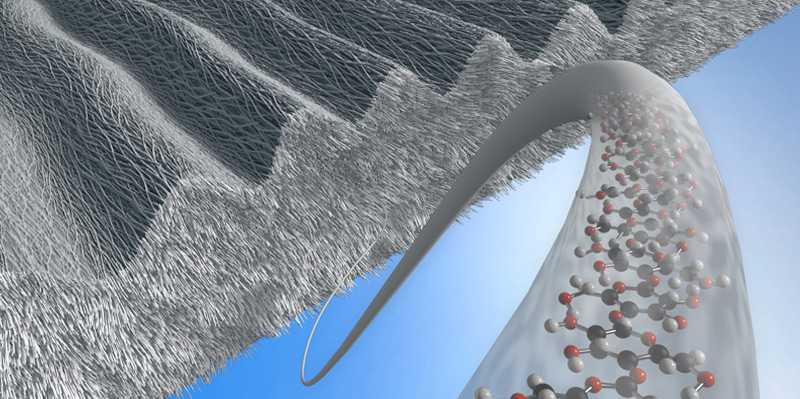Cellulose with Braille for cells
Artificial implants such as pacemakers often cause complications because the body identifies them as foreign objects. Researchers at ETH Zurich have now demonstrated a simple method to fabricate cellulose-sheaths for implants, whose micro-structured surface makes them especially biocompatible.
The human immune system distinguishes between endogenous and foreign bodies. This is highly useful when defending the body against pathogens, but can become a problem if a patient requires an artificial implant like a pacemaker or a heart assist device. In some cases the body responds with an inflammation, and it may even reject the device altogether. Researchers at ETH Zurich are now introducing a promising method to ameliorate this process –fabricating pre-structured cellulose materials that cover or coat devices with three-dimensional micro-structures and thus make them exceptionally biocompatible.
Researchers had already discovered that cells interact better with rough or structured surfaces than with smooth ones and can cling to them more effectively. However, until now it has not been possible to apply these surface structures to one of the most promising materials in the field of medicine: cellulose produced by bacteria. Bacterial cellulose has received major attention in research in recent years due to the fact that it is durable, adaptable and well tolerated by the human body. For example, practical tests are already being carried out on artificial blood vessels and cartilage made using bacterial cellulose. The versatile material is also an effective option for use as wound dressings.
A research team led by ETH Professor Dimos Poulikakos and Aldo Ferrari at the Laboratory of Thermodynamics in Emerging Technologies, has now succeeded in creating bacterial cellulose with a controlled surface structure. This is produced using a silicon mould with a three-dimensional, optimised geometry (such as a line grid) on a micrometre scale, which is then floated on the surface of a nutrient solution in which the cellulose-producing bacteria grow. The bacteria create a dense network of cellulose strands at the interface between liquid and air. The researchers observed that when the mould was present the bacteria conformed to it, producing a cellulose layer together with a negative replica of the line grid.
Surface structure conveys signals to cells
The line grid also enabled the bacteria to produce an increased number of cellulose strands in approximate alignment with the grid. "In principle, human cells have the ability to identify fibres, such as endogenous collagen, as part of the connective tissue," explains Aldo Ferrari. The cellulose strands and the grid pattern provide cells with an orientation along predetermined paths that they can sense. "This is of major benefit to wound dressings. Skin cells could grow over a wound more effectively if they moved in accordance with structured cellulose." The material also has a sort of memory: the structure is even retained when the cellulose is dried for storage purposes and moistened again just before use.
Poulikakos explains that in the production of cellulose surfaces, it is now possible to provide them with a message for the cells that will grow there in the future. "Think of it as a form of Braille." This enables the right 'message' intended for later use to be written on the surface.
Less inflammation due to a structured surface
Such structures serve not only as means of orientation for cells, but also help to minimise the body's rejection reaction to an artificial implant. In studies using mice, researchers compared smooth and structured cellulose and discovered that the mice with structured cellulose inserted under their skin showed significantly fewer signs of inflammation.
The researchers are now looking to follow up on these initial promising results by testing the material under more complex conditions. They could, for example, structure the cellulose surface of artificial blood vessels in a way that optimises the flow of blood, thereby ensuring that these vessels do not become blocked as easily.
In addition, researchers working with Poulikakos and Ferrari have founded the spin-off Hylomorph to make the method market-ready. "We are planning to apply the structured cellulose as part of the “Zurich Heart” project at the new Wyss Translational Center," reveals Poulikakos. The aim of this project is to develop artificial cardiac pump devices that help patients with serious heart problems in the period before a heart donor becomes available – they could even be used as a permanent alternative to a donor heart. Although cardiac pumps are already available, the options that they provide have been limited until now as they are not particularly durable and can cause complications. "Our aim is for artificial implants to be accepted by the patient’s body without inflammation or rejection," explains Ferrari. As part of the Zurich Heart project, the researchers are, in effect, helping to design the packaging and internal coating for the optimised cardiac pumps. The aim is to minimise the number of complications in the future.
Literature reference
Bottan S, Robotti F, Jayathissa P, Hegglin A, Bahamonde N, Heredia-Guerrero JA, Bayer IS, Scarpellini A, Merker H, Lindenblatt N, Poulikakos D, Ferrari A: Surface-Structured Bacterial Cellulose with Guided Assembly-Based Biolithography (GAB). ACS Nano, online publication, 19 December 2014, doi: external page10.1021/nn5036125call_made

